

Terraform: Infrastructure as code.End task of running "SYSMWIN" > Disable SYSWIN from Startup in Task Manager.Windows 10 De-Bloat and Customise June 4, 2021.Expand the existing Swapfile on Linux June 21, 2021.Enabling Snaps in Linux Mint 20+ July 12, 2021.Fan Speed Control on Dell XPS 15 running Linux September 30, 2021.Fix Ledger Nano X USB connection issues on Linux February 9, 2022.NET Assembly and WinSCP PowerShell Module. Automated FTP Operations from PowerShell 7 using WinSCP.Next Post Next Reset sysadmin password on VNX SEARCH… Search for: Search Areas of expertise Areas of expertise Recent Posts

To simply find zero-byte files and append their full pathnames to a logfile, useįor /r %F in (*) do if %~zF=0 echo “%F” > e:\logs\zerobytefiles.log Categories SAN/NAS/Storage, Windows Server Note: to set your source and destination paths in a batch file, use the following syntax This will remove the zero-byte files, allowing you to subsequently re-copy the now missing files from the source If you wish to include the command in a batch file, you’ll need to double up on the % characters,įor /r %%F in (*) do if %%~zF=0 del “%%F”

To recursively delete zero-byte files in your folder structure, use the following command The best solution I’ve found is to identify and delete any files that are zero-bytes in length before re-running another copy. Since the zero-byte files will have a newer time stamp than the source data, they become impossible to “fix” without potentially affecting surrounding files. The problems come when you re-run the copy in the hope that the zero-byte files in the destination folder structure are updated with healthy ones from the source. A common problem with data migration at the file level is that you can end up with users complaining of zero-length files.


 0 kommentar(er)
0 kommentar(er)
